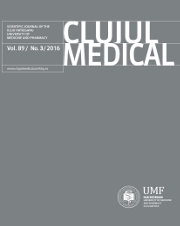COMPARISON BETWEEN A MULTI-PAVILION HOSPITAL AND A SINGLE PAVILION HOSPITAL
DOI:
https://doi.org/10.15386/cjmed-607Keywords:
Public Health, Health Care Economics and Organizations, Hospitals, RomaniaAbstract
Background and aim: Defining and measuring hospital efficiency is a hard task, in spite of the agreement that hospitals need to be efficient. Thus, while research might focus on the relationship between costs and outcomes, measurements differ significantly across studies.
The aim of the present study is to compare a multi-pavilion hospital with a single hospital from Cluj-Napoca, Romania.
Methods: Statistical and financial (effective expenses, salaries, drugs, materials, reagents, food) indicators were used to compare two hospitals from Cluj-Napoca: the Adults’ Clinical Hospital in Cluj-Napoca, and the Rehabilitation Hospital from Cluj-Napoca respectively. Data related to these indicators were collected at each hospital level, between 2004 and 2010.
Results: When investigating the expenses on medicine, data showed the two hospitals had similar values in 2004, 13.09% and 14.43% for the multi-pavilion hospital and single hospital, respectively. After 2004, the expenses started to drop simultaneously, being around 11% in 2006 and 2007 for both hospitals. The mortality rate was significantly different for the two hospitals. The multi-pavilion had a much higher mortality rate, when compared to the single hospital. From 2004 until 2007 a steady increase was observed for the multi-pavilion hospital, from 1.09 to 2.57 respectively.
Conclusion: The significant differences found between the two hospitals look being unavoidable, as long as they seem to stem from the hospitals’ ownership, their addressability and their targeted diseases and associated procedures.
Downloads
Published
How to Cite
Issue
Section
License
The authors are required to transfer the copyright of the published paper to the journal. This is done by agreeing to sign the Copyright Assignment Form. Whenever the case, authors are also required to send permissions to reproduce material (such as illustrations) from the copyright holder.

The papers published in the journal are licensed under a Creative Commons Attribution-NonCommercial-NoDerivatives 4.0 International License.

